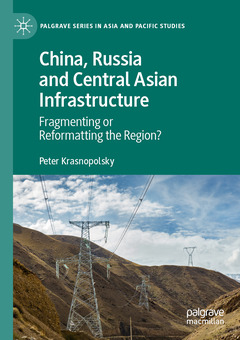Description
China, Russia and Central Asian Infrastructure, 1st ed. 2022
Fragmenting or Reformatting the Region?
Palgrave Series in Asia and Pacific Studies Series
Author: Krasnopolsky Peter
Language: English
Subjects for China, Russia and Central Asian Infrastructure:
Publication date: 08-2023
346 p. · 14.8x21 cm · Paperback
Publication date: 08-2022
346 p. · 14.8x21 cm · Hardback
Description
/li>Contents
/li>Biography
/li>Comment
/li>
This book evaluates Central Asian regionalism by analyzing the impact of Russia and China on physical infrastructure in the region. The narrative builds a picture of the nature of the two powers? influence on the development of regional connectivity in Central Asia. The study covers the 30-year period since the dissolution of the Soviet Union, with a focus on the last decade preceding the global pandemic. Qualitative research methods, i.e., documentary analysis, media analysis, and elite interviews, are implemented to explore how activities of Russia and China impact regional cooperation among Central Asian states. Multiple case studies of projects in the networked sectors of infrastructure, i.e., transportation, energy, and telecommunications, are used to build the argument and demonstrate the ways in which Russia?s and China?s engagement influence regional connectivity. The book is of interest to the scholars who study international relations in Eurasia, major power relations, Sino-Russian relations, China foreign policy, international institutions in Asia, multilateralism, and regionalism. The empirical depth of the book attracts attention of area studies scholars who focus on Central Asia, Central Eurasia, and any of the five Central Asian states. Additionally, the scholars who analyze the roles of hard infrastructure find the book particularly important. The in-depth cases on multilateral financial institutions and regional networks, particularly energy, transportation, and telecommunication, are of great value to those interested in these respective sectors.
Peter Krasnopolsky lived and taught in China for ten years. He conducted research in, Beijing, Bishkek, and Almaty and extensively traveled through China and Central Asia. Peter received Ph.D. from the University of Nottingham and Master’s from Nanyang Technological University in Singapore. He is based in Bayonne, New Jersey.




